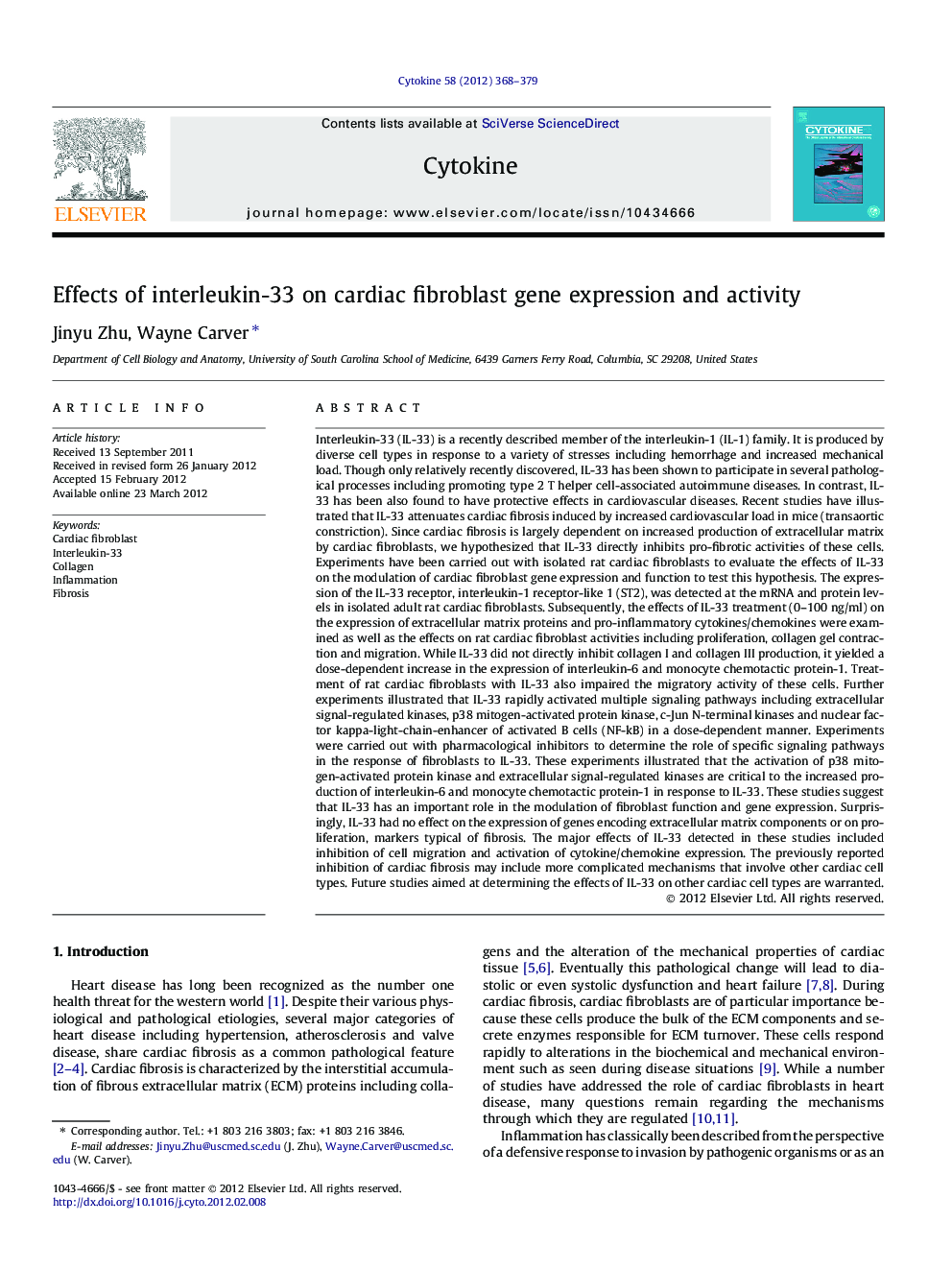| کد مقاله | کد نشریه | سال انتشار | مقاله انگلیسی | نسخه تمام متن |
|---|---|---|---|---|
| 2794416 | 1155283 | 2012 | 12 صفحه PDF | دانلود رایگان |

Interleukin-33 (IL-33) is a recently described member of the interleukin-1 (IL-1) family. It is produced by diverse cell types in response to a variety of stresses including hemorrhage and increased mechanical load. Though only relatively recently discovered, IL-33 has been shown to participate in several pathological processes including promoting type 2 T helper cell-associated autoimmune diseases. In contrast, IL-33 has been also found to have protective effects in cardiovascular diseases. Recent studies have illustrated that IL-33 attenuates cardiac fibrosis induced by increased cardiovascular load in mice (transaortic constriction). Since cardiac fibrosis is largely dependent on increased production of extracellular matrix by cardiac fibroblasts, we hypothesized that IL-33 directly inhibits pro-fibrotic activities of these cells. Experiments have been carried out with isolated rat cardiac fibroblasts to evaluate the effects of IL-33 on the modulation of cardiac fibroblast gene expression and function to test this hypothesis. The expression of the IL-33 receptor, interleukin-1 receptor-like 1 (ST2), was detected at the mRNA and protein levels in isolated adult rat cardiac fibroblasts. Subsequently, the effects of IL-33 treatment (0–100 ng/ml) on the expression of extracellular matrix proteins and pro-inflammatory cytokines/chemokines were examined as well as the effects on rat cardiac fibroblast activities including proliferation, collagen gel contraction and migration. While IL-33 did not directly inhibit collagen I and collagen III production, it yielded a dose-dependent increase in the expression of interleukin-6 and monocyte chemotactic protein-1. Treatment of rat cardiac fibroblasts with IL-33 also impaired the migratory activity of these cells. Further experiments illustrated that IL-33 rapidly activated multiple signaling pathways including extracellular signal-regulated kinases, p38 mitogen-activated protein kinase, c-Jun N-terminal kinases and nuclear factor kappa-light-chain-enhancer of activated B cells (NF-kB) in a dose-dependent manner. Experiments were carried out with pharmacological inhibitors to determine the role of specific signaling pathways in the response of fibroblasts to IL-33. These experiments illustrated that the activation of p38 mitogen-activated protein kinase and extracellular signal-regulated kinases are critical to the increased production of interleukin-6 and monocyte chemotactic protein-1 in response to IL-33. These studies suggest that IL-33 has an important role in the modulation of fibroblast function and gene expression. Surprisingly, IL-33 had no effect on the expression of genes encoding extracellular matrix components or on proliferation, markers typical of fibrosis. The major effects of IL-33 detected in these studies included inhibition of cell migration and activation of cytokine/chemokine expression. The previously reported inhibition of cardiac fibrosis may include more complicated mechanisms that involve other cardiac cell types. Future studies aimed at determining the effects of IL-33 on other cardiac cell types are warranted.
► IL-33/ST2 signaling was recently reported to have cardiac protective roles.
► We detected ST2 expression on rat cardiac fibroblasts.
► We investigated the regulatory roles of IL-33 on rat cardiac fibroblasts.
► IL-33 induced cell inflammatory cytokine but not the collagen production.
► MAPK and NF-kB pathways are important for this induced cytokine production.
Journal: Cytokine - Volume 58, Issue 3, June 2012, Pages 368–379